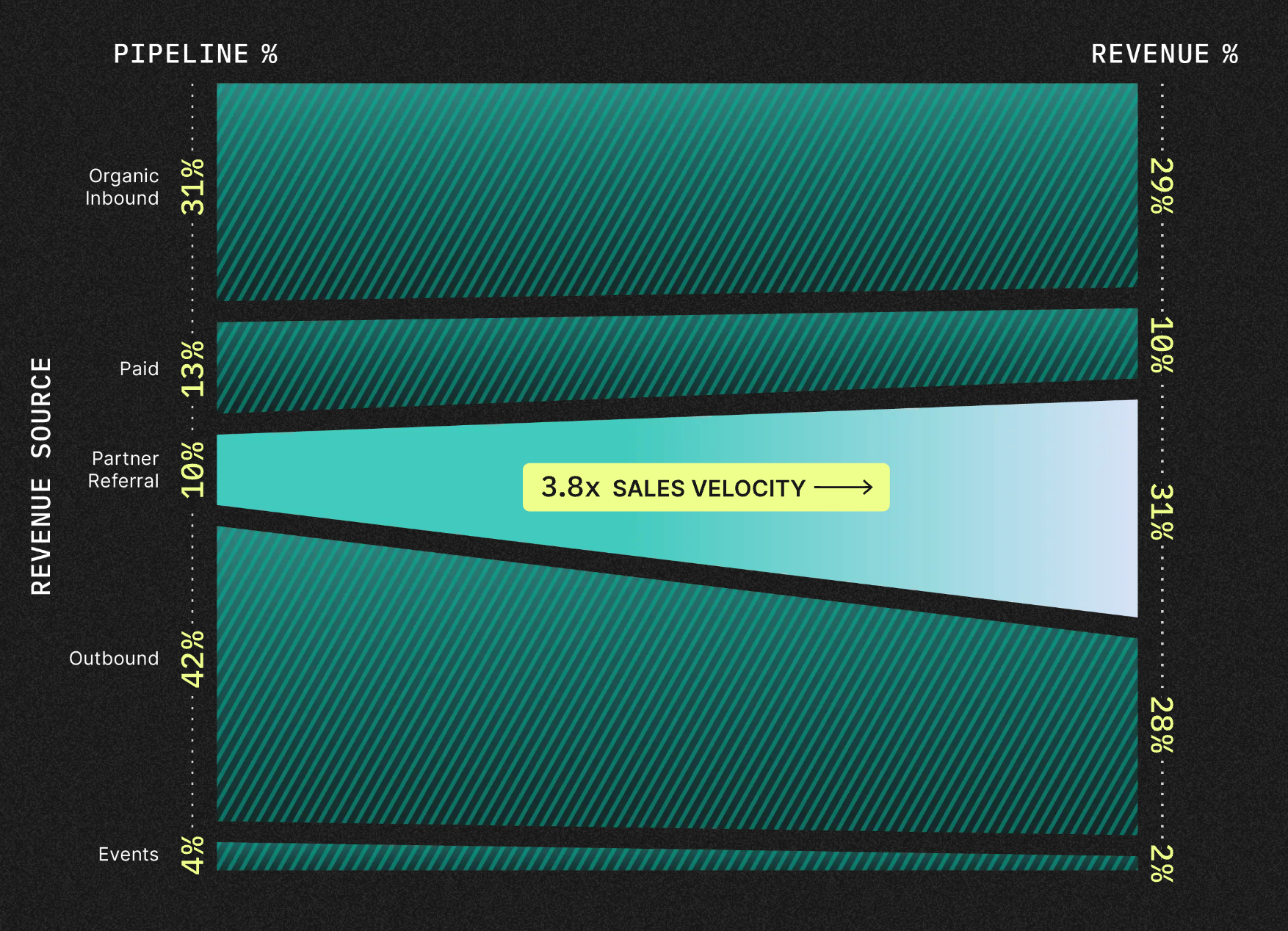When it comes to selling, you may always wish you could have more feet on the street. But, expanding your sales team and onboarding new sales reps can be extremely costly. This is where a channel sales enablement program can be invaluable. In a competitive market (like most B2B SaaS markets) having partners who know and love your product out in the field selling on your behalf can have some huge upside with lower internal costs.
Want to learn how to set up a channel sales program and corresponding sales enablement process? Read on for some easy to implement tips and real world examples of channel sales enablement.
Key Takeaways
- Channel partners can help you grow your revenue and expand into new markets
- You need to enable your channel partners to sell and promote your product or solution
- Engaging with channel partners often will help keep them engaged and working in your favor
- Creating the right channel partner program involves creating a compelling offer and equipping partners with the training, tools and resources they need (not unlike your sales team)
What is Channel Enablement in Sales?
Channel sales enablement is when your organization equips third-party partners with the information, tools, and systems they need to sell your company’s products or services to buyers.
Channel partners can act as an extension of your sales team. They can help by closing deals, expanding accounts, and providing ongoing support, onboarding and implementation services.
Benefits of Channel Sales Enablement
1. Increased sales (and revenue)
Put simply, a channel sales enablement strategy mobilizes partners to sell your product or services. This means more "feet on the street" and more people out there selling your product or services. If you enable their success, you should also benefit by seeing more sales and revenue come through your door.
Additionally, research from PartnerStack shows that "Partner referrals are only 10% of pipeline, yet they account for 31% of revenue. For top performers, the sales velocity delta of partnerships — the speed and efficiency at which deals are closed and generating revenue — is higher than other channels, yet out of companies surveyed by Pavilion and Ebsta, only 12% have a partnership program, meaning there’s revenue opportunities left on the table."

2. Improvements in partner engagement
When your partners are building businesses (and revenue) that include your product, you will see some improvement in partner engagement. It's important to remember these individuals and their businesses have chosen to align with you because they love your product, service, or solution. Asana, a popular project management tool, says their channel partner program offers the opportunity to attract new customers and identify new opportunities to support teams using Asana with training, consulting services, and professional services.
According to PartnerStack's research in 2023, "The most engaged partners within the PartnerStack Network are earning more revenue than ever before, contributing to the $390M+ in annual sales revenue driven by partners. Based on Q1 data, partners are on track to increase those earnings in 2024."
It's also worth noting many of the top SaaS companies across many verticals use PartnerStack's network for their partner programs. This includes companies like QuickBooks, Websflow, CallRail and Wistia.
3. A better customer experience
If you've been around the internet for the last decade or so, you've probably seen some management thought leader spewing some version of if you take care of your people, they'll take care of your customers. And when it comes to channel partnerships, this is extremely true. When you equip your partners with the right tools, training, and information, they will take great care of your customers, giving them a better customer experience than you could give them alone.
For example, some of the partners in Asana's ecosystem provide more hands-on, personal support for adopting their product than their internal customer success team could. Improving the experience for many smaller customers who may want a tailored onboarding and custom success plan (and be willing to pay a channel partner for that experience).
4. Reduced costs
Since channel partners are paid on commissions based on their sales volume, you can have more channel partners and not have the same cost as you would if you increased your headcount. You won't need to pay channel partners for their ramp time, as they can start selling on your behalf as soon as they've signed your partnership agreements.
Note that you will need to invest in someone to manage the channel partnerships program and the enablement part can be a big lift in that you'll need to design resources for your channel partners to use. This might look like a co-brandable pitch or training deck, training or certification courses for partners to learn from and prove their expertise or even providing them some co-marketing opportunities.
5. Scalability
Having a channel partner program can allow you to grow and scale your business in ways you might not be able to without a huge investment in your sales and marketing teams. By allowing channel partners to move into new verticals and bring on more customers you can grow and scale quickly and efficiently.
Five ways to effectively enable channel sales
A big part of running your channel partner program is your channel partner enablement strategy. So, if you're reading this and wondering what are the most effective ways to motivate and enable your channel partners, here are some ideas for inspiration!
1. Provide data and resources
Knowledge is power for both your sales team (which is why you have sales enablement) and your channel partners. So, take every opportunity to provide your channel partners with data and resources.
There are so many engaging ways to do this. On the data front, you can share any original research or powerful statistics from your customer success or sales team. For example, Asana creates and publishes their annual "Anatomy of Work," which contains tons of powerful statistics about how people are doing work and collaborating. This can be used to create messaging around using Asana as a productivity and collaboration tool.
When it comes to resources, you might want to share modified versions of your sales enablement collateral with your channel partners. This might include things like battlecards, comparisons to competitors, one sheets and even pitch deck templates they can co-brand and add the information about their services when meeting with prospects.
The easier you make it for channel partners to sell on your behalf, the more sales you're likely to see. A win for everyone!
2. Encourage networking and collaboration
When it comes to channel partnerships, think collaboration over competition. While some healthy competition between partners might not be a bad thing, this tip is really about providing opportunities for your channel partners to collaborate and promote their services.
Having a shared Slack workspace, Discord, Circle or similar platform for channel partners to ask each other questions and find opportunities to network and provide each other referrals can have a big impact on your channel community. In addition to providing these opportunities it is also a place where you can share information and updates and engage with your channel partners en masse.
3. Share results and updates periodically
Like your sales reps, your channel partners will want to hear how things are going. Since they aren't company employees you may not be able to share as much, as quickly with this group, but remember to share what you can when you can.
In many cases channel parters are covered under a nondisclosure agreement, which means you can share confidential information with this group.
You might want to share their collective impact as well as information about the impact of new features or solutions you provide. You will need to provide guidance here on what can be shared with clients or partners.
4. Ask for feedback
Since your channel partners are also on the frontline with your customers ask them how things are going. You may be able to learn a lot from your channel partners about what customers are saying -- things they may not tell you or your customer success team.
Your channel partners may also be able to provide some critical intel about early sales conversations - what sales collateral is resonating most, what competitors come up a lot and what sales objections do they hear over and over again.
Finally, you also want to hear from them periodically about the partner program itself. How are you doing when it comes to channel sales enablement? Are you providing the right tools, training and resources? Is the compensation for selling and serving accounts still feeling compelling? What else do your channel partners want or need from you? Actively listening and providing the right content, resources and even rewards can help you keep current channel partners happy and engaged as well as recruit new partners as you need them to grow.
5. Promote your channel partners
Offer channel partners promotional opportunities. This could include adding a directory of your channel partners to your website, offering channel partners the opportunity to be featured on your social media channels or podcast if you have one, as well as providing speaking opportunities to get them in front of potential customers.
This doesn't have to be complicated or expensive. In fact, it can be a huge asset to your content teams. For some inspiration, look at ClickUp's partner listings or QuickBooks Partner Program information - especially the part where they've collected and shared some success stories.
How to build out your own channel sales enablement strategy
If you want to add channel sales to your strategy, here is how you can get started and build up a channel sales team with an excellent partner enablement program to ensure your partners are getting up to speed quickly.
1. Determine who would make a good channel partner for your business
Like you've come up with an ICP for your customers, you may also want to think through the ideal profile for your channel partners. For example, if you're selling a CRM or sales enablement software, the ideal partner might be independent sales coaches or trainers. If you're selling accounting software, you might consider accounting firms as a channel partner. Or, if you're selling project management or collaboration software, you might want to work with virtual assistants, fractional project managers or someone similar to become a channel partner for you.
Determining this profile will involve looking at your potential partner's customer base. Is this an audience that is a good fit for your product, solution or service? If the answer is an enthusiastic yes, that person or firm might be a great channel partner for you!
2. Recruit a few partners for a pilot program
As with most things in sales and marketing, you want to test, not guess. So recruiting a few potential channel partners to pilot a program is a smart idea. You want enough folks to get good, statistically significant data, but not so many you're overwhelmed trying to provide the right level of support and enablement for your pilot.
3. Create an onboarding sequence and enablement materials for your channel partners
Your enablement process will need to start with a good onboarding, even in your pilot mode. Start by creating a channel partnership agreement that your channel partners will sign outlining all the rules of your program and how much commission they can make and when it will be paid out.
Then, you'll need to determine what training or certification your channel partners will need to complete to become official channel partners. This might involve some short lessons or courses as well as quizzes or a final exam. You can choose how you want to kick things off and refine this process based on feedback.
4. Get feedback on your program
Once your pilot partners are onboard, check in periodically to see how it is going. Their feedback will drive your enablement strategies. Look at their performance results and ask them how they are feeling. Do they think they can take on more clients, are they feeling overwhelmed? Is the compensation feeling worth it commensurate with the work they need to do either directly with customers or indirect sales? Is there more information they would want to have about your products, services or competitors.
Consider using both surveys and partner interviews to solicit the most useful feedback in this phase.
5. Begin to expand your program to see if it scales
As soon as you're getting good feedback from your channel sales partners, you can begin to expand your program to see if it can scale. Start reaching out to those with similar backgrounds to your most successful partners from your pilot. Or better yet, ask them to invite new partners from their network who provide complementary services or have an overlap of the skills you need.
Your enablement strategy might need to evolve as the program grows, you may need to rely on an enablement platform to support all of the partner enablement content and training you need to produce and distribute.
6. Create a community for channel partners to network
As your program begins to grow, consider adding an element of community to your channel sales enablement program by offering your channel partners a way to connect, network and share questions and answers. While you will need a community manager to oversee this and share communication from the organization as well as share FAQs and insights from the community, there is a good chance you will see the community members become active and help each other when they can.
7. Expand your program and iterate as needed
While we've already discussed the need to get feedback on your channel sales program and channel sales enablement strategy, its not a one and done activity. As you continue to expand the program and welcome new channel partners, keep a pulse on how things are going. Ask for feedback in the community, send regular surveys and don't be shy about asking the community what they want and need.
In the same vein, you want to also look inward. How is the channel sales program working for your organization? Are you seeing the right ROI?
Take all of these learnings and continue to iterate on your program and engagement strategies as needed.
How can Qwilr help with your channel sales enablement?
If you're looking for a channel sales enablement platform, look no further than Qwilr. We make it easy to create and share resources with your channel partners that they can use to learn about and promote your products, solutions and services. Qwilr can help you create and customize:
- Training materials
- Pitch documents
- Battle cards
- One sheets
- Pricing Tables
- ROI calculators
- And so much more!
If you want to see Qwilr in action and learn how to create all of these documents, as well as digital sales rooms to share them in, contact us today to book a demo.
About the author

Marissa Taffer|Founder & President of M. Taffer Consulting
Marissa Taffer is the Founder & President of M. Taffer Consulting. She brings over 15 years of sales and marketing experience across various industries to a broad range of clients.
Frequently asked questions
Channel sales enablement is when your organization equips third-party partners with the information, tools, and systems they need to sell your company’s products or services to buyers.
Benefits include increased sales and revenue, improvements in partner engagement, a better customer experience, reduced costs, and scalability.
You can enable channel sales by providing data and resources, encouraging networking and collaboration, sharing results and updates periodically, asking for feedback, and promoting your channel partners.
You can build your strategy by determining good channel partners for your business, recruiting partners for a pilot program, creating an onboarding sequence and enablement materials, getting feedback on your program, expanding your program to see if it scales, creating a community for channel partners to network, and expanding your program and iterating as needed.
Channel partners can act as an extension of your sales team. They can help by closing deals, expanding accounts, and providing ongoing support, onboarding and implementation services.


